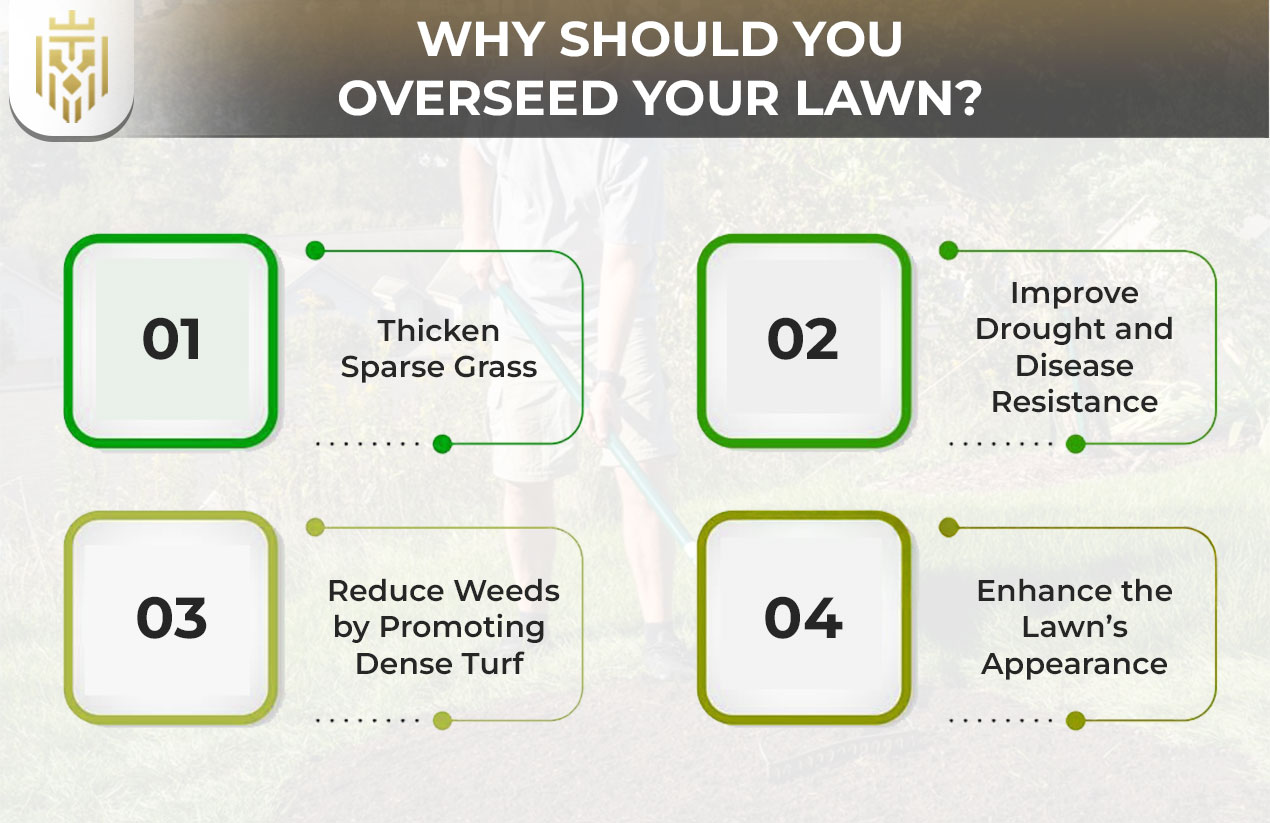What is Overseeding a Lawn?
Overseeding involves placing new grass seed over what’s already growing instead of removing it. This way of seeding will cover empty spots in the lawn, make the lawn thicker and increase grass type diversity. Overseeding your lawn adds vitality and makes it more attractive than it was before, all without the hassle of replacing the entire lawn.
Why Should You Overseed Your Lawn?

Overseeding the lawn strengthens thinning areas, hides lawn gaps and helps it handle weeds, lack of water and sickness. The look, fullness and health of a lawn is enhanced by overseeding the grass with new varieties.
Thicken Sparse Grass
Overseeding your lawn thickens sparse areas, boosts its toughness and makes it look better. Using a spreader to apply grass seed over your lawn improves the look and health of empty areas. Replanting lawn seeds helps protect the grass from bugs, drought and illnesses.
Improve Drought and Disease Resistance
Fertilizing your lawn with overseed during fall will help it tolerate both drought and common diseases. On a thick turf comprised of new types of grass, it is easier for moisture to collect, dangerous pathogens are stopped and unwanted weeds are outcompeted. Mixing grass seed varieties helps keep your grass healthy and prevents a lot of disease issues.
Reduce Weeds by Promoting Dense Turf
Lots of grass grown by overseeding leaves few spaces for Lawn weeds to settle. The fresh grass and quality seed growing across the field block the sun from reaching weed seeds, so fewer weeds grow. Reducing weeds in your lawn is natural when you choose to overseed.
Enhance the Lawn’s Appearance
An overflowing lawn raises your property’s front yard appeal. It plants grass and seed in bald spots, covers the lawn and makes the root system thicker. When you use lawn overseeding, your lawn stays fresh, attractive and looks the same all year round.
Best Time for Overseeding Lawn
When to spread grass seed for cool-season grass is in late August or mid-October. If you overseed your lawn with warm-season grass in late spring, it will thrive. Seeding your grass at the proper time helps it grow and take root better.
-
Cool-Season Grass
Cool-season grasses should be overseeded in their lawns from late August to mid-October. By planting at this time, you give the grass seed a chance to sprout and create strong roots before winter. A lawn with fewer weeds leads to a better outcome when you are overseeding.
-
Warm-Season Grass
Overseeding your warm-season lawn should happen in late spring when the soil temperature rises above 65°F. Grass seed germinates better in warmer air. Do not sow your garden too early, as early growth on cold ground reduces the chances of good results.
How Often Should You Overseed a Lawn?
A good practice is to overseed your lawn both in spring and in fall, with germination happening from 7-21 days in ideal conditions. Following this routine encourages new growth in grass, covers any bare spots and gives a thick lawn all summer. If you oversow your lawn in fall, your grass will have sturdier roots next season.
How to Overseed Your Lawn?

Start with a low mow, remove anything from the ground, consider aerating and divide and scatter the grass seed evenly over the lawn. Add fertilizer to the soil, water regularly and wait until your new grass reaches a decent height before you mow the lawn. Treat any empty areas in your lawn with caution.
-
Mow the Lawn Short
Cut your lawn short before you start overseeding so the grass seed touches the soil. Having less cover over your lawn helps the sun and water reach your grass and provides space for it to grow. It also lowers the chance of competition with existing grass, helping seedlings become established.
-
Rake to Remove Debris
Raking your lawn before overseeding removes obstacles that can keep the seeds from touching the soil. The process makes the soil a little softer, helping the grass seed start to grow more rapidly. It gives your next lawn the chance to grow well and thrive.
-
Aerate the Lawn (If Needed)
Aerating the soil allows air, nutrients and water to reach it, making overseeding the lawn easier. Whichever tool you use, aerating grass gives seed the chance to grow and creates sturdy roots that go deeper into the soil.
-
Spread the Seed Evenly
When you are overseeding, ensure you pick a grass seed that works well with your current lawn. Spread it evenly throughout the area you want to keep healthy for balanced growth. Blending right mixing grass seeds with each other adds new grass evenly and gets rid of patches to create a lush lawn.
-
Fertilize the New Grass
After you plant the grass seed, use a starter fertilizer especially formulated for new grass. Don’t use herbicides that prevent seeds from sprouting. Proper fertilization after overseeding your lawn feeds the growing seedlings and helps them set strong roots quickly.
-
Water Regularly
After overseeding your lawn, water it once deeply and afterwards, water lightly each day. Giving water to grass seed regularly encourages sprouting and promotes new grass growth. Don’t change your mowing until the grass you planted reaches the same height as the lawn.
-
Avoid Mowing or Heavy Traffic
Wait until the new grass is 1–2 inches high before walking or cutting the overseeding lawn areas. Very young plants can be damaged when you mow or walk on freshly sown grass. Keep the areas seeded untouched because too much walking can harm the new grass.
FAQs
1) What is Overseeding a Lawn?
Overseeding involves placing new grass seed over what’s already growing instead of removing it. This way of seeding will cover empty spots in the lawn, make the lawn thicker and increase grass type diversity. Overseeding your lawn adds vitality and makes it more attractive than it was before, all without the hassle of replacing the entire lawn.
2) How Often Should You Overseed a Lawn?
A good practice is to overseed your lawn both in spring and in fall, with germination happening from 7-21 days in ideal conditions. Following this routine encourages new growth in grass, covers any bare spots and gives a thick lawn all summer. If you oversow your lawn in fall, your grass will have sturdier roots next season.
3) How to Overseed Your Lawn?
Start with a low mow, remove anything from the ground, consider aerating and divide and scatter the grass seed evenly over the lawn. Add fertilizer to the soil, water regularly and wait until your new grass reaches a decent height before you mow. Treat any empty areas in your lawn with caution.
4) Why Should You Overseed Your Lawn?
Overseeding the lawn strengthens thinning areas, hides lawn gaps and helps it handle weeds, lack of water and sickness. The look, fullness and health of a lawn is enhanced by overseeding the grass with new varieties.







